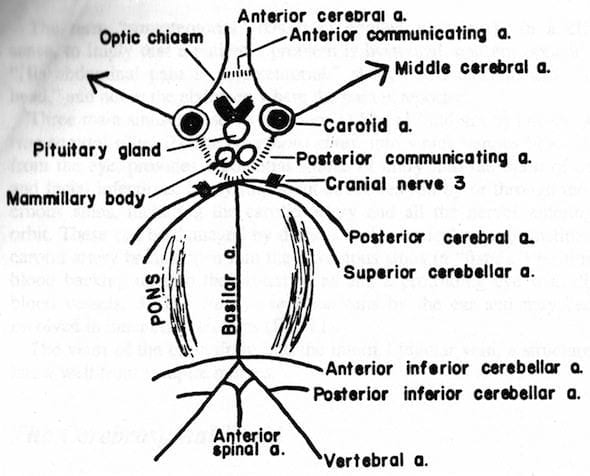A Spider called Willis
Following on from Gates’ demystification of brainstem lesions, here is an excerpt from Stephen Goldberg’s imaginative means of remembering the Circle of Willis (my insertions in square brackets):
A ferocious spider lives in the brain. His name is Willis! Note that he has a nose [pituitary gland], two suckers [mamillary bodies], eyes that look outward [internal carotid arteries], a crew cut [anterior communicating artery – blood flows in either direction], antennae [anterior cerebral arteries], a fuzzy beard [posterior communicating arteries – again, blood flows in either direction], 8 legs, a belly that, according to your point of view, is either thin (basilar artery) or fat (the pons, which lies from one end of the basilar artery to the other), two feelers on his rear legs [posterior inferior cerebellar arteries], and male genitalia [anterior spinal artery]. Willis has hairy armpits – the third cranial nerve exists between the posterior cerebral artery and the superior cerebellar artery [the first two sets of legs]. The cerebellar arteries were named by a real SAP (S – superior, A – anterior inferior, and P – posterior inferior) [SA – the last two sets of legs] and supply the cerebellum and brainstem.
References
- Gates P. The rule of 4 of the brainstem: a simplified method for understanding brainstem anatomy and brainstem vascular syndromes for the non-neurologist. Internal Medicine Journal 2005; 35: 263-266 [PMID 15836511]
- Goldberg S. Clinical Neuroanatomy Made Ridiculously Simple. MedMaster Series, 2000 Edition.
- Patten J. Neurological Differential Diagnosis. Springer-Verlag.
LITFL Links
- Brainstem Rules of 4 (original rules)
- Helpful Brainstem Figures (original figures)
- The rule of 4 of the brainstem (Rules re-imagined)
- Using the Brainstem 1
- Using the Brainstem 2
- The Magic of the Neuro Exam
- Look Left, Look Right (Internuclear Ophthalmoplegia)
- More Befuddling Pupillary Asymmetry (Horner Syndrome)
Chris is an Intensivist and ECMO specialist at The Alfred ICU, where he is Deputy Director (Education). He is a Clinical Adjunct Associate Professor at Monash University, the Lead for the Clinician Educator Incubator programme, and a CICM First Part Examiner.
He is an internationally recognised Clinician Educator with a passion for helping clinicians learn and for improving the clinical performance of individuals and collectives. He was one of the founders of the FOAM movement (Free Open-Access Medical education) has been recognised for his contributions to education with awards from ANZICS, ANZAHPE, and ACEM.
His one great achievement is being the father of three amazing children.
On Bluesky, he is @precordialthump.bsky.social and on the site that Elon has screwed up, he is @precordialthump.
| INTENSIVE | RAGE | Resuscitology | SMACC

